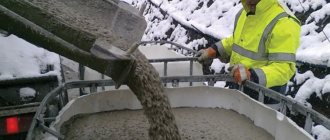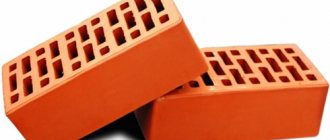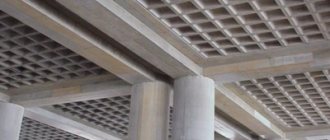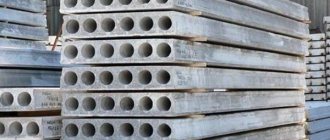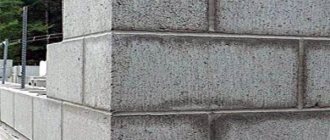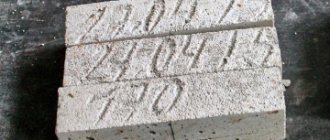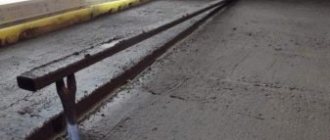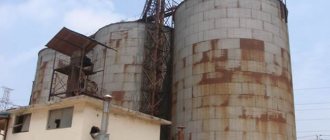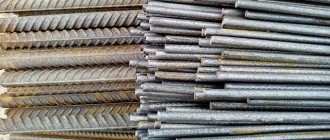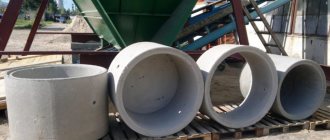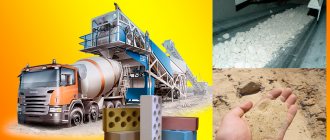Autoclaved cellular concrete is a high-quality material with many positive characteristics, including reliability and sufficient strength. Thanks to this, this raw material can be used even for the construction of tall buildings, plus it can be used in partitions. In this article, we propose to understand what autoclaved concrete is and its technical characteristics, as well as its possible types.
Cellular concrete in different designs Source deal.by
DIY making
It is quite possible to prepare cellular concrete yourself. The problem is solved in several ways.
Non-autoclaved aerated concrete
The equipment includes detailed instructions and a disk that explains both the manufacturing technology and the principles of operation of the devices. The cost of the device is 57–58 thousand rubles.
Foam concrete
Foam concrete is prepared using a slightly different technology.
Purchasing equipment makes sense when a fairly large construction project is underway - not a garage or outbuilding. If the amount of work is small, it is more profitable to rent equipment.
The video below will tell you about the production line for the production of cellular concrete:
What is a building material
The material is produced in the form of volumetric fragments, which may differ in size depending on the batch. It is a material that lasts for years without a hint of deformation. This suggests that the quality of this composition has been tested by time. Using blocks produced using autoclave hardening technology, it is even possible to construct load-bearing partitions.
Cellular blocks for the construction of pulp with a foundation Source asm.ru
Appendix B (mandatory). Method for determining frost resistance of cellular concrete
B.2 Preparation for testing
B.2.1 Frost resistance tests are carried out when cellular concrete reaches a compressive strength corresponding to its compressive strength class.
B.2.3 The number of samples for testing cellular concrete for frost resistance must be at least 24:
12 - main ones, subjected to freezing and thawing, to determine the loss of compressive strength after testing;
6 - control, not subjected to freezing and thawing, to determine the loss of compressive strength;
3 - main ones, subjected to freezing and thawing, to determine mass loss after testing;
3 - control, not subjected to freezing and thawing, to determine weight loss.
B.3 Test performance
B.3.2 The air temperature in the freezer should be measured in the center of its working volume in close proximity to the samples.
B.3.3 The duration of one freezing cycle at a steady temperature in the chamber of minus (18±2) °C must be at least 4 hours, including the time of temperature reduction from minus 16 °C to minus 18 °C.
B.4 Processing test results
B.4.1 The relative reduction in concrete strength, %, is calculated based on the results of a compression test of the main samples after a given number of cycles of alternating freezing and thawing and control samples at an age corresponding to the number of frost resistance test cycles, according to the formula
where is the average strength of the main samples after a given number of cycles of alternating freezing and thawing, MPa;
— average strength value of control samples at an age corresponding to the number of frost resistance test cycles, MPa.
B.4.2 Relative mass loss, %, is calculated from the results of determining the mass of the main samples after a given number of cycles of alternating freezing and thawing and control samples at an age corresponding to the number of frost resistance test cycles, according to the formula
where is the average mass of the main samples dried to constant weight, g;
Kawabanga! Brands and varieties of cements and their features
— average value of the mass of control samples dried to constant weight, g.
B.4.5 Initial data and test results of the main and control samples must be entered in the test log in the form given in Appendix B.
Features of the technology
Autoclave hardening is a manipulation that is a structure consisting of several components: a base and an additive. The latter are selected individually depending on the purpose for which the material is being manufactured.
Thanks to this approach to the production of building materials, it is possible to achieve ideal quality, which will subsequently correspond to the selected operating conditions. The entire process of block formation occurs under high pressure and temperature. The hardening process takes place over several hours. Experts say that it is not necessary to push the hardening to the maximum. Only 70% of the strength index is enough, after which you can stop the process. When the material cools, it will not collapse and will meet all standards. In this form it is put up for sale.
Autoclaved concrete with a cellular structure Source spb.portalsnab.ru
Concept
Autoclaved aerated concrete (AAC) is a concrete material for the construction of walls, obtained by keeping it in autoclaves at a temperature of 191 degrees and under a pressure of 12 atmospheres. All this is necessary in order to give aerated concrete hardness, accelerating the hardening process.
Under such conditions, the mineral tubemorite is formed in the structure of the material, which gives aerated concrete improved qualities. The formation of bubbles inside the material is facilitated by the reaction of aluminum paste and lime. AGB is also called artificial synthesized stone.
This aerated concrete is suitable for the construction of both internal and external walls, and its insulating properties are its main advantage. Due to the fact that the autoclave material has perfectly smooth edges and precise dimensions, the walls of houses “grow” quite quickly.
Large enterprises are engaged in the production of autoclaved aerated concrete. Small artisanal companies produce non-autoclaved concrete, which is an ordinary foamed sand-cement material that dries in the fresh air. This type of aerated concrete is much worse in quality than autoclave concrete. And often it is in houses that are built from non-autoclaved aerated blocks that the walls crack and crumble.
Advantages and disadvantages
The advantages and disadvantages of the material are presented in the table
| Advantages | Flaws |
| · Strength, which can be increased by reinforcement. · Environmental friendliness. · Resistance to mold and rot. · Fire resistance. · Ease of processing (cutting, grinding); Even with the help of hand tools, you can shape the blocks into any shape. · Good ventilation and sound insulation create a comfortable microclimate. · Low thermal conductivity, heat retention in the room. · Frost resistance, high resistance to sudden temperature changes. · Light weight reduces transportation costs. · Large block size speeds up construction. | · Hygroscopicity. Absorbs moisture upon prolonged contact with it, which at low temperatures deteriorates the quality of the material. · To fasten heavy structures, fasteners (plastic expansion anchors) are required. · Fragility, which makes it difficult to move. |
A shortcoming such as hygroscopicity can be corrected using waterproofing impregnation or a coating containing tile adhesive.
Water protection is necessary if it is:
- underground parts of buildings (basement, foundation, basement);
- first row of masonry;
- a room with high humidity (swimming pool, shower, bathroom).
What is the difference between autoclaved concrete and non-autoclaved concrete?
In this section, we propose to analyze the main characteristics of autoclaved concrete and, in order to clearly understand why it is used more often, we attach a table with the comparative characteristics of non-autoclave hardening blocks.
Initially, the consistently high quality of autoclaved aerated concrete and the shrinkage process during operation are noted. Shrinkage occurs only when excess moisture contained in the material evaporates. On average, autoclaved concrete blocks shrink by 0.5 m/mm over five to ten years, and this is quite a bit in contrast to non-autoclaved ones: 2-3 mm/m.
Let's look at a comparison of the technical characteristics of two different blocks in the table below.
| Characteristics | Autoclaved concrete | Non-autoclaved concrete |
| Frost resistance class | F15 0 | F15-F30 |
| Density, kg/m3 | D400-D700 | D600-D800 |
| Thermal conductivity, W/mS | 0.15 | 0.19 |
| Flammability class | NG | NG |
| Strength | B 2.5-B-5 | V 1.5-V 2.5 |
| Durability | 150 years | 50 years |
If we look at the totality of all the listed characteristics, we can conclude that the ideal option for the construction of residential buildings is blocks produced using autoclave hardening technology. If it is necessary to build a garage, cellar, hangar or warehouse, then a non-autoclave type block would be ideal.
Laying autoclaved cellular blocks Source blokshop.ru
What types of blocks are there?
Autoclaved cellular concrete may vary. There are three types of blocks in total that are made using this technology. They are divided into types depending on volumetric mass:
- Easy. This version of autoclaved concrete has a minimum density. It can vary from 300 to 1200 kg/cubic meter. A similar value is obtained only if numerous bubbles are present in the composition. The disadvantages of this raw material are that it does not have high strength indicators, which accordingly limits its capabilities and scope of use.
- Cellular. Its density is 1200-1800 kilograms per cubic meter. Such blocks are ideal for the construction of load-bearing walls if it is a low-rise private house. If a multi-storey building is being erected, then such blocks are used only as components for enclosing partitions.
- Heavy. The density of this is 1800 kg/cubic meter and higher. In this case, the compression strength class corresponds to B7.5-B 35. The indicator varies depending on the composition and exposure of the raw material in the autoclave.
Types of concrete with a cell structure
In addition to the main types of concrete, which are produced by autoclave hardening, there are also additional classifications. These include the following two types.
Gas silicate
The composition of gas silicate blocks includes lime, sand and steam-forming additives with water. Such blocks are always made with an emphasis on all construction GOST standards. The whole process consists of mixing the necessary components, which are added in a certain order and in specific proportions to achieve the desired strength result.
When the mixture is completely ready, it is sent to a special form, where the hardening process takes place together with a chemical reaction, as a result of which pores are formed inside.
Autoclave curing gas silicate block Source avito.ru
Aerated concrete
Autoclaved aerated concrete is a cellular artificial stone in which the pores are evenly distributed throughout the volume. Such concrete is produced in industrial workshops and does not contain any additives that could harm human health during the operation of the material.
The composition of this type of blocks includes sand, cement, lime, water, gypsum, aluminum paste. Pores are formed as a result of the hydrogen evolution reaction. Only after hardening has passed, the finished material is divided into blocks of the required size. All these fragments have an ideal shape and size, so during the installation process there is no need to make appropriate adjustments. Also, all blocks lie as evenly as possible, resulting in no gaps in the seams.
Specialized aerated concrete blocks of neat shape Source alfa-brick.ru
Scope of application of autoclave blocks
Autoclave blocks with a porous structure can be used in various conditions. First of all, due to the presence of this type of material in construction, it is possible to form reinforced slabs for concrete floors that act as partitions or load-bearing structures.
Autoclaved aerated concrete blocks with increased strength properties are often laid in seismic zones; they are also used in regions where natural disasters often occur. They also try to make partitions from this material, if necessary, to build a warm building, since it has increased thermal insulation.
This material is also used in construction conditions, where it must be processed correctly and quickly. For example, if you need to trim, level, polish edges, drill.
As for such a type of raw material as gas silicate block, it is mainly used in the construction of buildings that should last for decades. This raw material is definitely required for work where there is no need for a large load on the foundation (especially for places with floating soils).
Construction of aerated concrete blocks with a cellular structure Source beton-house.com
